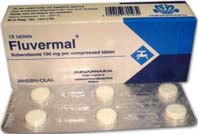
Fluvermal
ANTHELMINTIC
Description :
Fluvermal is a synthetic broad- spectrum anthelmintic.
Fluvermal is available as oral tablets containing 100 mg flubendazole and as a drinkable suspension containing
20 mg flubendazole per ml. Chemically, flubendazole is methyl 5-(p-fluorobenzoyl)- 2-benzimidazolecarbamate with a molecular weight of
313.29.
Properties:
Fluvermal interferes with cellular tubulin formation in the worm, thus disturbing glucose uptake and the normal digestive functions of the worm to such an extent that an autolytic process occurs. Flubendazole is poorly absorbed after oral administra- tion. At the normal anthel-nintic dosage, the bioavailability is poor because of the combination of high first-pass metabolism and a very low solubility of the drug. 90% of the small fraction that is absorbed is bound to plasma proteins.
Indications:
Fluvermal is indicated for the treatment of single or mixed infestations by Enterobius vermicularis (thread- worm/pinworm); Trichuris trichiura (whipworm); Ascaris lumbricoides (large roundworm); Ancylostoma duodena le, Necator americanus (hookworm).
Contra-Indications:
Fluvermal is contraindicated in persons who have shown hypersensitivity to the drug.
Adverse reactions:
Only minor adverse reactions to FLUVERMAL have been reported. Transient abdominal pain and diarrhoea have only rarely been reported, in cases of massive infestation and ex- pulsion of worms. Hypersensitivity reactions such as exanthema, rash, urticaria and angio-oedema have rarely been observed.
Precautions:
Use in infants <1 year: As well-documented experience in children below 1 year of age is scarce, Fluvermal should only be given to very young children if their worm infection interferes Significantly with their nutritional stat- us and physical development.
Use during pregnancy and lactation:
Although Fluvermal gives no evidence of teratogenic properties in animals, possible risks from Fluvermal during pregnancy should be weighed against the expected therapeutic benefits, particularly during the first trimester. It is not known whether Fluvermal is excreted in human milk. Therefore caution should be exercised when Fluvermal is administered to nursing women.
Dosage and Administration:
1) Enterobiasis: 1 tablet or 5 ml drinkable suspension given as a single dose.
Since reinfections by Enterobius vermicularis are very common, it is recommended that the treatment be re- peated after 2 and 4 weeks, particularly in eradication programmes.
2) Ascariasis, trichuriasis, ancylostomiasis and mixed in- fections: 1 tablet b.i.d. or 5 ml drinkable suspension morning and evening for 3 consecutive days. The dosages above apply to children as well as adults. No special procedures, such as diet or use of laxatives, are required. For infants <1 year, see underPrecautions.
Overdosage:
In the event of accidental overdosage, abdominal cramps, nau e ,vomittng-and diarrhoea mavet:HAlthough the maximum recommended treatment dura-
tion of Fluvermal is limited to three days there have been ” rare reports of reversible “liver function “disturbances, hepatitis and blood dyscrasias described in patients who were treated for hydatid disease with massive doses for prolonged periods of time. There is no specific antidote. Gastric lavage with aque- ous potassium permanganate at 20 mg/100 ml may be performed. Activated charcoal may be given.
How supplied:
Fluvermal tablets (each containing 100 mg flubendazole) is supplied in packs of 18 tablets. Fruvermal drinKable suspension (contalnrng 0 mg-per ml) is supplied in bottles of 30 ml. The suspension should be shaken before use.
Store between 15_0 and 300 C. Protect from light.
produced by :
JANSSEN-ClLAG
MINAPHARM
Under licence of
JANSSEN PHARMACEUTICA· Belgium
